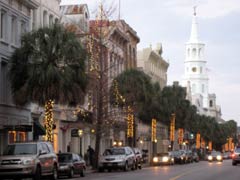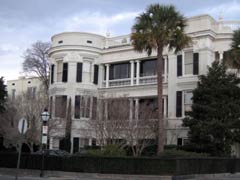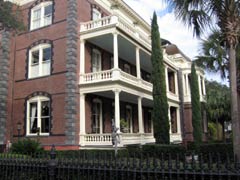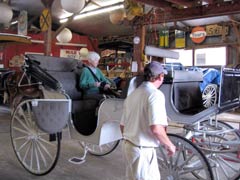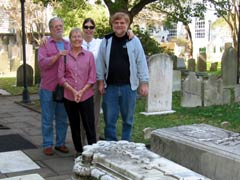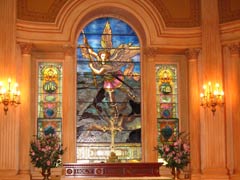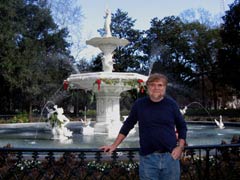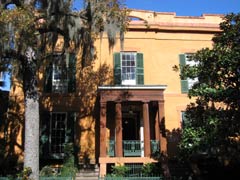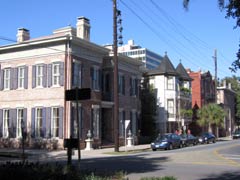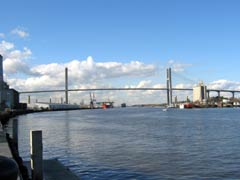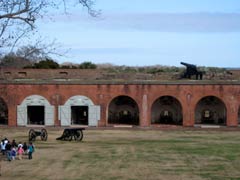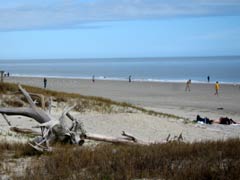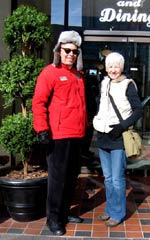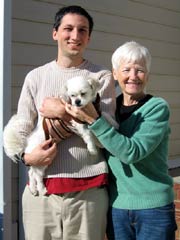January 28, 2008
On to Greenboro
We headed north from Charleston along the coast. We passed by Myrtle Beach, the Red-Neck Riviera. Despite the wonderful, fine, white sand, it seemed like an awful place with hotel after hotel on a narrow beach. The development was overwhelming. We just kept heading north until we got to Wilmington, NC, where we spent the night. The next day we drove around the city. It has a beautiful historic district. We took some pictures. I keep on messing up by not taking enough photos, but we took a few in Wilmington.
To see all our photos for this entry, press HERE for a slideshow.
Cassidey’s in Wilmington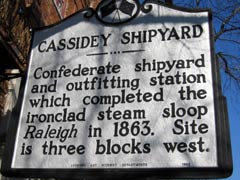 |
At the Greensboro History Museum 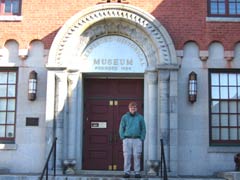 |
The Old Mill of Guilford 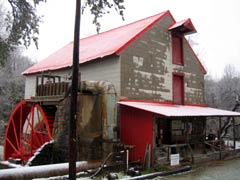 |
In Old Salem 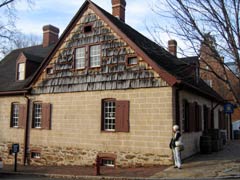 |
In the Gunsmith’s Shop 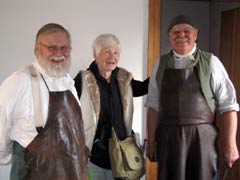 |
In The Bakery 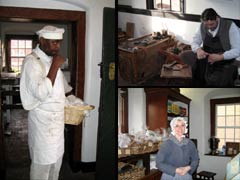 |
After leaving Wilmington we drove north and east. We stopped in Magnolia, NC, in order to visit the Duplin Winery. There is a variety of grapes that in native to the coastal plains of NC, that being the muscadine grape. The grape produces more than 10 times the anti-oxidants found in normal grapes, making muscadine wine very healthy to drink. It makes a decent white wine with a very strong floral bouquet. However, this wine was not for me. I prefer red wines to whites. Even so, it would take a while for me to get use to muscadine wine. If you ever get a chance to try it, I highly recommend that you do as there is nothing else like it and it is pretty good. A couple of hours after leaving the winery, we were in Greensboro.
The last time I was in Greensboro, I had come to rebuild the stairway in my sister’s home. This time Betty and I came to be tourists and hang with Dawn and Mitzi. One of the first places that we visited was the Greensboro History Museum. It is a really cool museum. It had lots on local history from the earliest immigrants and settlements to the civil rights movement. It case you do not know it, the lunch-counter sit-ins started in Greensboro. Another area that many gun-nuts might enjoy is the civil war gun collection. The collection is very large with a large variety of musket types and manufactures.
We visited an art museum. We went to a couple of movies. There is an old, working flour mill out by the airport in Gilford. We went out to buy muffin mixes and ground grits, rolled oats and steel cut oats. The Old Mill of Guilford was established in 1767 and continues to be operational. The mill is powered by water and produces a variety of corn meals and grits, whole wheat flour, bran, barley and oats.
Our next foray was to Old Salem, which is a section of Winston-Salem that dates to colonial times. Old Salem seems like a museum in and of itself. But some of the old homes are still occupied by ordinary people. There is a large museum. It has a children’s toy collection and historical decorative arts and furniture, both of which were well worth visiting. We also wandered in to a very old gun smith shop. The gun smiths explained how the old muzzle loaders were crafted. They both make brand new rifles for the public. Their craftsmanship was excellent. We dropped into an old cobbler’s shop to see him making shoes. We saw many of the old buildings in the area. We saw the old graveyard from afar. And finally we stopped at the bakery, where they use the large old open fire ovens.
I also want to mention a side trip that I made to Chapel Hill on Saturday. It is a very beautiful college town. I was surprised once again by the beauty of the old homes and stores, not to mention the great old university buildings. It seems that the East is very different than the Midwest and the West. Homes, buildings and towns are much older and very often very beautiful.
January 14, 2008
Charleston: Historic Center of the Old South
Betty and I spent several wonderful days in Charleston, South Carolina. 400 to 600,000 people live in and around Charleston. That makes it a bit larger than Savannah. It has an extremely large historical district with buildings dating from the 1700’s. But because of fires, most of the homes, governmental, commercial and churches were built in the 1800’s. The homes are larger and grander than in Savannah. The largest home is about 24,000 square feet. There was a recent sale of more than $7 million for one of these large antebellum mansions.
We did a couple of tourist tours through the town. One was in a carriage, which was relaxing and very interesting. The second was a bus-tour that concentrated on Black history and arts. Just to let you know, Charleston was the center of the slave trade before the civil war. So, the second tour was extremely interesting. We learned about Free Blacks who were slave owners. We learned about a Black rebellion in 1822 that was stopped before it started, when the 35 ring leaders, including Denmark Vesey, were hung and the rest we shipped out of Charleston. About 75% of the 25,000 people that lived in Charleston in the 1820’s were slave. We got to see the homes of the free Blacks. The major local handy-craft arts are quilts, baskets made of sweet grass and iron works. The greatest of the blacksmiths to produce wrought iron works is Phillip Simmons.
The weather was abnormally warm the first couple of days we were there, almost hitting 80f or 27c. We could not have asked for better. Now it is hard to believe that it has a sub-tropical climate, but the summers would be unbearable if not for modern air conditioning. We had many great meals there. We enjoyed seafood nearly everyday.
We stayed with Margaret Ford, a good friend of Mickie Turk. She was a wonderful host and showed us much of the city. One day we visited some friends of hers that are caretakers for an old society house. Skip and Sue Johnson explained the history of the house, which was used as a school for orphans when it was originally built, but is now mostly rented out for weddings and other galas. We visited St. Michael’s church and its graveyard, where at least one of the Declaration of Independence signers is buried. Later that day we all visited the Gibbs Museum of Art.
To see all our photos from Charleston, press HERE for a slideshow.
We had a great time in Charleston. It is rich in history. We met so many friendly and charming people in Charleston.
January 10, 2008
Savannah
Betty and I visited Savannah, Georgia, for a couple of days. It is one of the most beautiful cities in the USA. About 300,000 people live in and around Savannah. The city has a historical district that is about two square-miles. There several broad boulevards and twenty-plus city squares. The streets are lined with southern oaks heavy with Spanish moss. Most homes were built between 1860 and 1900 in the historical district. Moving beyond this area there are many homes built in the early 1900’s.
We stayed out on Hope Island. We couchsurfed in an old farm house. Hope Island has many lovely old homes with access to the ocean.
We also visited Fort Polaski and Tybee Island. Tybee Island has a beautiful beach. It was warm enough to sun ourselves, but we did not stay long.
Take a look at the photos. Be sure to click on what interests you, because you will see so much more. To see all our photos from Charlotte and Savanah, press HERE for a slideshow.
Our next visit will be to Charleston.
View from Hope Island
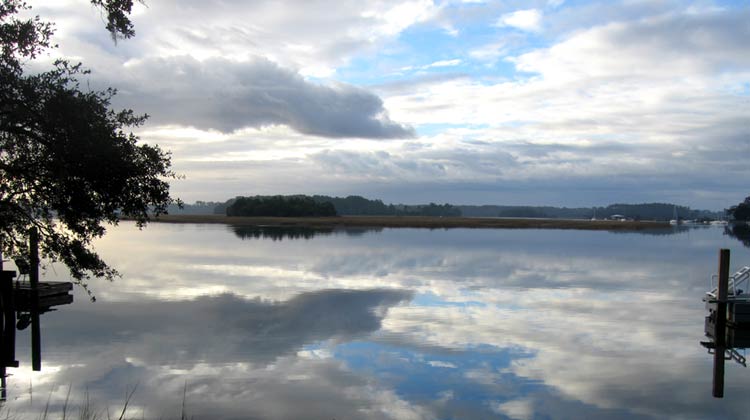
January 07, 2008
Charlotte
After five weeks in the tundra to meet our new granddaughter, it was time to remove ourselves to warmer climes. Charlotte ended up being more of a transition than a true transformation, because in was still a bit cold at night – dipping down to the 20’s that left frost on the car windows in the morning.
Public Art Aplenty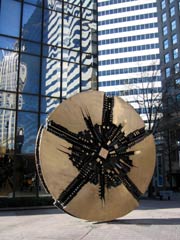 |
Lovely Murals to See 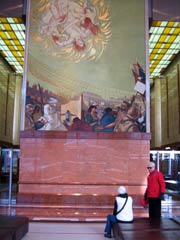 |
To see all our photos from Charlotte and Savanah,
press HERE for a slideshow.
We had never spent anytime in Charlotte before. So, we learned quite a bit about the city. In the city proper, there are about 600,000 people. The metro area is said to have 1.5 to 2.5 million people. Based on what I know about cities, the lower end of the estimate sounds more real. The vast majority of the local residents are transplants, most often from another state. They are new to the area because the growth in the city is new. Perhaps this is a result of Charlotte’s emergence as the second largest banking center in the USA. Lack of planning has made for many new roads that came in response to the growth and leaves the city feeling a bit haphazardly built. I thought the town would be rich with history and filled with historical buildings. This is not the case. The only really old neighborhood is called the Fourth Ward. Here most of the homes were built in the late 1800’s and early 1900’s, but the neighborhood is quite small covering only 20 or 30 blocks. We walked though the neighborhood admiring the older homes in less than an hour.
We had a guided walking tour of the downtown, which is called Uptown and is adjacent to the Fourth Ward. Here we saw a few older building, mostly churches. The modern city center is filled will skyscrapers built by banks. The two largest are the Bank of America and Wachovia. We also found some good public art. As far as amenities go, they have a very good new light rail system that the public seems to love. Because there has been so much growth in recent years, the style of development outside the city center has been predominantly suburban. In way of explanation for my foreign readers, this means extremely low density housing far from the city center many shopping centers springing up to serve the new residents.
We did couch surf one night. We spent the day with Hunter Tabony. He and his wife Cierra had spend eight-months traveling in 2006. They circumnavigated the world on a minuscule budget. One of the ways that they were able to make do was by using Couchsurfing.com and the Hospitality Club. We shared travel stories all day on Saturday. In the early evening we visited Diane Collins. She and her husband Bill were couch surfer hosts. She had invited us to dinner, where we talked about our travels, our lives and our children. She is a most gracious person. When we returned to Hunter’s home, we awaited the arrival of Cierra. She had worked long and hard on Saturday, not arriving home until after 11 PM. She is a veterinarian who works at an emergency animal care clinic. When she got home we sat up talking another hour or so, but weariness soon overtook us all and the night quickly drew to a close.
In the morning we got to know Cierra better. We play a game of cribbage before she had to leave for the clinic. They are a wonderful and generous couple.
We left midday on Sunday. We headed south and drove for many hours. We stopped only for lunch. We did take a sixty-mile detour off the freeway to get a sense of rural South Carolina. No, we did not meet any one from Deliverance. We stopped for the night about 40 miles north of Savannah, Georgia.
I will write about Savannah in few day.
Until then, take care.
